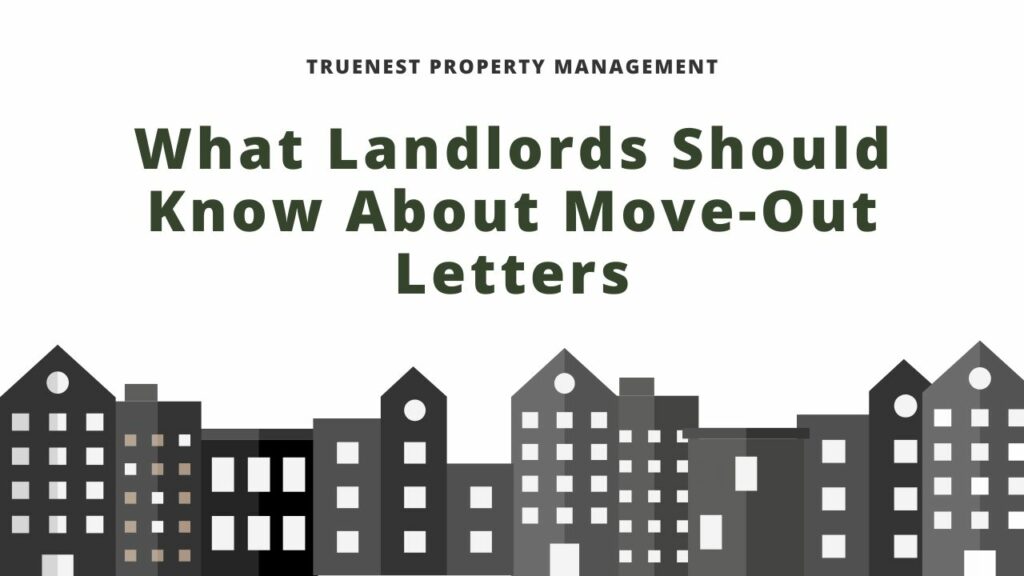What Landlords Should Know About Move-Out Letters

While renting out a property, there might come a time when you have to ask a tenant to vacate the premises. To smooth out the process, protect your investment, and leave your unit in the best condition possible, it’s recommended you have a move-out letter ready to be used.
What is the purpose of such a letter, what are its benefits, and what should be its contents? In this article, the expert team from TrueNest Property Management advises you on how to go about it.
The Purpose of a Move-Out Letter
When the lease agreement ends, both the landlord and the tenant can choose to terminate or renew the lease. Should either party choose to terminate the tenancy, they may be required to provide notice of their intention to the other party.
When a landlord chooses to end the tenancy, it is recommended they provide a move-out letter on top of the required notice. A move-out letter can help protect your investment and your interests as a landlord, as its purpose is to relay your expectations regarding the property to the tenant.
The Advantages of a Move-Out Letter
A move-out letter is advantageous to both the moving tenant and the landlord, as it:
- Relays your expectations to the tenant. Once received, the tenant will understand what is expected of them when vacating the property, and what condition they should leave the unit in.
- Provides a timely schedule. A move-out letter is clear on when the tenant should move out and when the landlord will stop by to inspect the premises. This gives the tenant time to clean the property and conduct any necessary repairs or renovations.
- Expresses good faith. The move-out letter is a good example of open communication between both parties, and serves to cement the good relationship the landlord has had with the tenant so far.

How to Write a Move-Out Letter
While not every property or tenant is the same, there is certain information that should always be included in a move-out letter, such as:
- The letter’s delivery date, regardless of its method of delivery.
- Your contact information, including your phone number and email.
- The reason for terminating the lease and the expected move-out date. Should the tenant wish to renew, and should you be open to it, you can include a clause/procedure on how to renew the lease and what the new lease terms would be.
- The notice period. This should be in line with relevant Florida landlord-tenant laws.
- Details on the inspection of the property. Let the tenant know you’ll conduct a walk-through property inspection with them. Mention that you’ll provide the tenant with an itemized list of necessary repairs and renovations, as well as end-of-tenancy cleaning instructions.
- Important information regarding the return of the keys and the reimbursement of the security deposit. Be sure to familiarize yourself with the relevant rental laws and remain compliant throughout the process.
- Any important dates. Apart from the inspection dates and the expected move-out date, you can mention when the tenant can expect to receive the balance of the security deposit.

While all of the provided information should always be included in a move-out letter, it’s important to remember that no two landlord-tenant relationships are the same. That’s why it’s recommended that landlords get in touch with a professional property manager who can help them tackle and personalize move-out letters accordingly.
Is a Move-Out Letter an Eviction Notice?
Although it may initially sound like it, a move-out letter is not an eviction notice, nor is it similar to it. A move-out letter is usually delivered when the lease agreement is up for renewal, as a way to let the tenant know the landlord will not be renewing their contract.
An eviction notice entails a legal procedure, as an eviction can only occur when a tenant fails to comply with the terms of the lease agreement. If a landlord wants to serve a tenant an eviction notice, they will have to provide evidence in a court of law and liaise with local enforcement officers to remove the tenant from the premises.
If you need help differentiating a move-out letter from an eviction notice, get in touch with a reputable and experienced third party that can advise you on the matter.
Benefits of Working with a Property Management Company
A good move-out letter should be clear and detailed. It should outline the landlord’s intentions and expectations when asking a tenant to move out, including their expectations regarding the condition of the property.

Any requirements or clauses regarding property maintenance should address the difference between normal wear and tear and property damage. Move-out letters should also adhere to Florida’s landlord-tenant laws in order to avoid any legal complications and ensure a smooth tenant turnover.
To navigate the situation, landlords may want to consider working with a reputable and experienced property management company. A dependable and reliable service provider will be able to put together the ideal move-out letter and offer a whole range of services landlords can take advantage of.
Conclusion
A move-out letter not only protects your investment but also ensures that your returns remain consistent. Should you need to delegate that duty to a third party, the ideal property management company in Broward County is TrueNest Property Management.
Get in touch with us today and receive an affordable quote for our property services and solutions!
